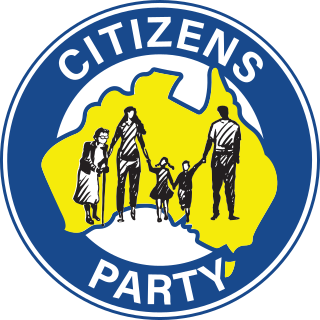Top Qs
Timeline
Chat
Perspective
Australian Citizens Party
Political party in Australia From Wikipedia, the free encyclopedia
Remove ads
The Australian Citizens Party (ACP), formerly the Citizens Electoral Council of Australia (CEC), is a minor[4][5][6] political party in Australia affiliated with the international LaRouche Movement, founded and originally led American political activist and conspiracy theorist[7] Lyndon LaRouche.
The ACP campaigns on "restoring Australia’s national and economic sovereignty",[8] with a focus on banking reform, including a "Glass-Steagall" division of Australia’s banks separating commercial from investment banking;[9] an amendment to the Banking Act guaranteeing Australian bank deposits against a "bail-in";[10] and a new government-owned bank, with a retail division operating in post offices.[11] The ACP is federally registered with the Australian Electoral Commission.[12]
The party has pushed conspiracy theories, including that international action on climate change and indigenous land rights are part of a conscious fraud masterminded by Prince Philip, as part of the British royal family's scheme to depopulate the planet.[13][14] It ‘believes Prince Philip is trying to break up nation-states through the World Wide Fund for Nature and is involved in a "racist plot to splinter Australia"’.[15]
Founded in 1988, the party has been led by Craig Isherwood ever since.[16]
Remove ads
History
Summarize
Perspective
The original CEC was established in 1988 by residents of the Kingaroy region of Queensland.[citation needed] CEC candidate Trevor Perrett won the 1988 Barambah state by-election in Queensland, after former Queensland Premier Sir Joh Bjelke-Petersen resigned in 1987. However, Perrett switched to the National Party in December 1988.[17] Members of the Australian League of Rights, an extreme right-wing group led by Eric Butler, tried unsuccessfully to take over the new party.[4][failed verification] Its purpose was to lobby for binding voter-initiated referendums.[18][19]
By 1989, the CEC leadership was under the influence of the Lyndon LaRouche movement.[4] By 1992, the CEC identified itself as the Australian branch of the broad international LaRouche movement. National Secretary Craig Isherwood moved the headquarters from rural Queensland to a Melbourne suburb, with direct communications links to LaRouche's US headquarters established.[18]
In 1996, then-Liberal Party MP Ken Aldred was disendorsed by the Liberal Party after using parliamentary privilege to make allegations that a prominent Jewish lawyer and a senior foreign affairs official were involved in espionage and drug trafficking. Aldred made the claims using documents supplied to him by the CEC that were later found to be forged.[20][4][21]
In 2004, the CEC received the largest contribution of any political party, $862,000 from a central Queensland cattle farmer and former CEC candidate named Ray Gillham.[22][23] The party collected $2.3 million in donations in 2020-21.[24] In the 2022–23, it raised approximately $1.4 million from 336 donations.[25] The party’s leader is National Secretary and National Treasurer Craig Isherwood of Melbourne, who has been a candidate for the party numerous times.
Remove ads
Platform
Summarize
Perspective
The ACP, citing historic figure King O'Malley as inspiration, lobbied for "the establishment of a National Bank and State Banks to provide loans at 2% or less to agriculture (family farms), industry and for infrastructure development", launching a petition in 2002 to drive support with a full page advertisement in The Australian newspaper.[26] In early 2008 the CEC started campaigning for a "Bank Homeowners Protection Bill of 2008", calling for legislation in the spirit of the Australian moratorium laws enacted in the 1920s and 1930s.[27] The party continues to campaign for establishing a government-owned bank using the Australia Post network.[28][29]
The party follows the LaRouche line of denying the theory of anthropogenic global warming; it claimed in 2009 that the Copenhagen Summit, a climate conference occurring that year, was planning "massive population genocide‚ on a scale that would make Adolf Hitler blush" and the establishment of a "world government".[30] The party espouses the claim that the Port Arthur massacre, in which Martin Bryant murdered 35 people and injured 37 others, was instigated by mental health institute the Tavistock Institute on the orders of the royal family,[31] and that the Australian Liberal Party was founded by pro-Hitler fascists.[32]
The CEC's other policies have included introducing a national Glass-Steagall Act to "break up the banks", introducing a moratorium on home & farm foreclosures, constructing high speed rail and the Bradfield Scheme, joining China's Belt and Road Initiative, shutting down Pine Gap and denying the existence of climate change.[3]
Remove ads
Reception
In 2007, the Anti-Defamation Commission of the Australian branch of B'nai B'rith (an international Jewish organisation) has published a Briefing Paper with details of the CEC's alleged antisemitic, anti-gay, anti-Aboriginal and racist underpinnings. The document cites CEC publications and quotes former CEC members.[4] The CEC published a response to the ADC, stating it was an antiracist organisation.[33]
Former members of the CEC and families of current members have accused the group of "brainwashing" members and engaging in campaigns involving "dirty tricks".[34] For example, former CEC staffer Donald Veitch has claimed that new recruits undergo "deprogramming sessions" and that recruits are probed for sexual transgressions. Veitch has stated "The mind control operations commenced by Lyndon LaRouche in the USA in the mid-1970s are still being practised today within his movement in Australia".[35]
Electoral results
Summarize
Perspective

Despite running in "almost every election of the past two decades", in no election has the CEC ever garnered more than 2% of the vote.[36]
At the 2007 federal election, the CEC's previous form continued. Its first preference votes in the lower house was 27,879 (0.22%), and 8,677 (0.07%) in the upper house, both results were 0.14% down from 2004.[37]
At the 2016 federal election, CEC fielded senate candidates in every state and the Northern Territory and seven candidates for seats in the House of Representatives.[38] Nationally, the party received 5,175 votes (0.04%) in the lower house and 9,850 votes (0.07%) in the upper house.[39]
Remove ads
See also
References
External links
Wikiwand - on
Seamless Wikipedia browsing. On steroids.
Remove ads

